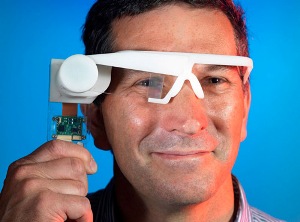Jul 8 2014
The National Physical Laboratory (NPL) has developed a revolutionary optical component for augmented reality devices in partnership with a new British company, TruLife Optics.
 The component can be integrated into headsets or eyeware like this first prototype to provide an improved augmented reality experience
The component can be integrated into headsets or eyeware like this first prototype to provide an improved augmented reality experience
Augmented reality devices enable people to view the world around them overlayed with data relevant to what they are seeing. Applications range from head-up displays on car windscreens showing speed, navigation and safety information, to headsets worn by surgeons during operations providing them with live health data from the patient.
The patent-pending optic, which incorporates two holograms, offers several unique advantages for these devices. For example, images can be displayed in high definition, full colour, in perfect focus and in 3D (with a different image for each eye) through the centre of a field of vision.
Critically the image is transparent, allowing for the perfect overlay of information on whatever subject is being viewed. The optic itself is lightweight, less than 2 mm thick, and can be easily mass-produced for consumer and industrial applications.
Simon Hall, Lead Scientist in Adaptive Optics at NPL, said:
"Together with the TruLife Optics team, we have created a genuinely game-changing technology that will lead to the acceleration in the development of augmented reality devices and applications."
Watch a video about TruLife Optics' technology:
TruLife Optics launches groundbreaking product for the augmented reality industry
London-based TruLife Optics, a spin out from established holographic technology company Colour Holographic, is selling the ground-breaking optic through its website for all developers of augmented reality devices.
The product consists of a glass waveguide, approximately 10 cm long, 3 cm wide and 2.8 mm in thickness, which contains two postage stamp sized holograms. The light is transmitted into the first hologram and then turned 90 degrees through the length of the waveguide, via total internal reflection, before hitting the second hologram and being turned a further 90 degrees so it is projected into the human eye.
This allows for overlaid transparent images to be projected from the centre of the optic in perfect focus.
Jonathan Lewis, Chief Executive of TruLife Optics, said:
"The development of wearable augmented reality devices has been curtailed by the lack of an optical component that allows for the genuine overlay of high-definition, full colour and transparent images over the field of vision.
"Today, with the launch of our first commercially available optic, we provide that missing piece in the augmented reality jigsaw puzzle."
TruLife Optics will work alongside developers of augmented reality devices to provide customised, bespoke solutions based on the patented technology. NPL will continue to work with TruLife Optics to further develop the technology and to provide additional sales and marketing support.